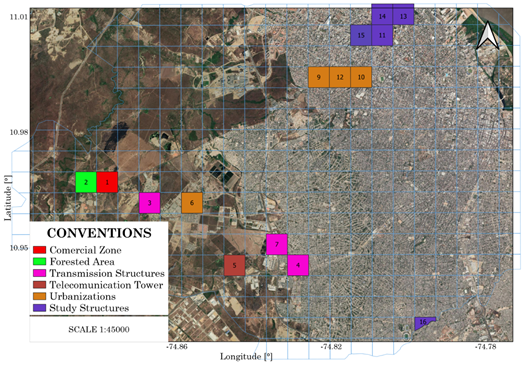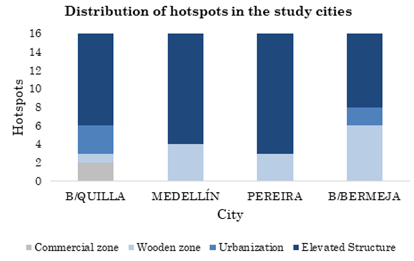1. INTRODUCTION
Global lightning activity is variable due to changes in the flash rate per thunderstorm, the number of thunderstorms, or both [1]. Studies show that the mean global total ground flash density is approximately 8.3 flashes/km2/year, about 3.4 times the mean global total flash density over oceans [2]. Likewise, Lightning activity is predominant in the northern Atlantic and western Pacific Ocean basins during all-year periods due to instability caused by cold air passing over warm ocean water. A low lightning frequency has been recorded in the tropical eastern Pacific and the Indian Ocean basins, where the air masses are much warmer [3].
Research has found that of the 500 lightning hotspots on earth, 283 are located in Africa, 87 in Asia, 67 in South America, 53 in North America, and 10 in Oceania.
However, the site with the highest number of flashes per square kilometer per year is located on Lake Maracaibo to the north of Venezuela, which are recorded in total 233 flashes/km2/year [4], followed by the hotspot previously found in The Congo Basin with a total of 205 flashes/km2/year [3]-[7].
In Africa, most high-frequency lightning sites were located in a central region of the continent in the Mitumba mountains in the Congo, and in Guinea [4], [8]. In Asia, the Hotspots are found mainly along the Himalayas in the Indus Plain, located in the northernmost part of Pakistan, and the Kashi Hills on the border between India and Bangladesh [9], [10]. In North-Central America, these sites were found predominantly near a mountain range called the Sierra Madre in Patalul and Catarina in Guatemala and Rosamorada, Mexico [11].
Coldspots were also found on this continent, which implies a minimum vulnerability to human impacts and some industries; they were located on the Caribbean Sea side of Central America [12]. All the hotspots in Oceania were located on the north coast of Australia, except for the fifth hotspot, established in Papua New Guinea [13]. In Europe, some hotspots have also been found in the southern foothills of the Alps in the northeastern of Italy, but with low activity compared to those named at the beginning [14].
In South America, the main hotspots were located near or in the valleys or foothills of the northern Andes Mountains in Colombia, and Venezuela [4], where it was suggested that lightning activity in these areas depends on the severity of the storm and the orography [15].
Seven of the ten places with the highest lightning flash rate density in this continent are in Colombia since its territory is located in the intertropical convergence zone where the southeast and northeast trade winds converge. The three mountain ranges that cross the country's surface serve as a natural barrier [4], which favors the formation of electrical storms between the Magdalena River Valley, the Cauca River Valley, the North-Central region and the Catatumbo.
Forming points of high lightning activity in specific sites such as Cáceres, El Tarra, Norcasia, Majagual, and Santa Rosa [16]. In this way, it has been possible to conclude that around 8 million cloud-ground flashes per year are recorded in Colombia [17].
Other studies in Colombia have related the sites of high lightning activity with the variation of the peak lightning current, finding an inverse relationship between the Cloud-to-Ground Lightning Flash Density (CGLFD) and Peak Current [18].
While in winter storms in mid-latitudes, it is observed how elevated structures correspond to very high lightning activity points, tropical regions such as Colombia present very high Ground Flash Density (DDT) values. So, using this parameter, it is difficult for activity at a specific point or on any structure to exceed the average for the region. Therefore, the identification of Hotspots is not evident, nor is the influence of elevated structures located there. So far, the sites of high lightning activity in Colombia have been determined based on the spatial occurrence of CG flashes through the DDT parameter, and the temporal occurrence has not been taken into account as proposed in this work. Nor have been found or characterized these specific sites in the analysis cities with the proposed resolution. Since the places of high lightning activity have been found using squares of 3 and 1 km on each side.
Knowledge of this natural phenomenon and its characterization is of the utmost importance since it allows the design of more robust protection systems and the elaboration of plans to protect human lives and mitigate material damage and economic losses. The above, since lightning strikes make vulnerable protection devices on tall structures and life support and assistance systems, cause outages in transmission and distribution lines, compatibility problems in communications networks, and directly affect different aviation systems, sports spaces, or scenarios with a high concentration of people [19]. Consequently, there are human and economic losses and affectation of the quality indicators of electrical energy [20].
This paper determines the places with the greatest amount of lightning strokes in specific country cities, like Medellin, Barranquilla, Barrancabermeja, and Pereira. The above is based on information provided by the Colombian Total Lightning Detection Network with LINET technology. It starts from the location of possible lightning event places such as elevated structures, public places, and open spaces. We propose that the areas with the tallest structures in each study city correspond to the sites with the highest incidence of lightning [21].
1.1 Lightning flashes in Colombia
1.1.1 Keraunic Level (KN) and Ground Flash Density (GFD)
The first characterization of lightning parameters was made between 1974 and 1988 with the implementation of the first map that indicates the keraunic level (KN) [17], which measures the number of stormy days per year in a given region but is not very useful in determining the places with the highest lightning activity. For this, the parameter of Ground Flash Density GFD is used, which measures lightning flashes per square kilometer per year as (1).
Where k and a are constants valid only for where the expression was raised. This parameter has been determined through direct measurements with lightning counting equipment or locators and empirical equations that relate the Ground Flash Density with the keraunic level [17].
1.2. Colombian Total Lightning Detection Network with LINET technology
In September 2011, the Colombian Total Lightning Detection Network with LINET technology came into operation. LINET is a system made up of magnetic field antennas that operate in the low frequency (LF) and very low frequency (VLF) and provides for each stroke parameters such as the time of occurrence, latitude, longitude, the amplitude of the return current, polarity, and type (cloud to ground or intracloud) using arrival time techniques [22]. The LINET network comprises 19 stations strategically distributed throughout the Colombian territory. The separation between sensors varies between 90 and 140 km [23], as shown in Figure 1, where the points show the study cities.
With this distribution, the detection efficiency of CG strokes is 99 % in the central areas of the country, 95 % for more remote regions such as the Pacific, the Caribbean region, the western Orinoquía, and Bajo Cauca, 90- 80 % for the eastern Orinoquía and the southwest of the country, and 60 % for the Amazon. These efficiency values decrease considerably for IC strokes and vary between 80 and 20 %. The LINET network average location error is close to 300 meters [24].
Each station records the magnetic field waveform and its timestamp when a lightning flash occurs. The detection data is sent in real-time by each station to a Central Processing Unit. The lightning detection algorithm that identifies and determines the discharge parameters is executed. Each measurement station comprises a magnetic field antenna that operates in the VLF/LF frequencies, a GPS antenna, and a signal processing unit. With this network, it has been possible to build updated maps of the GFD in Colombia, and important studies have been made in which the variation of GFD is related to the topography, showing that the sites with the highest lightning activity coincide with the foot of mountains and valleys [19], [25].
2. METHODOLOGY
2.1 Selection of the departments and their respective cities of analysis
In Colombia, the narrow mountain ranges, mainly the Oriental (Northwest of Cundinamarca and Southwest of Boyacá) and Central (Northeast of Caldas, Southeast of Antioquia), and winds that approach them, mark the primary influence on the Ground Flash Density. Therefore, the study cities' first criterion was their geographical location, evaluating height above sea level, proximity to mountain ranges, and terrain topography. According to the methodology proposed by NTC 4552-2 [26], three types of damage appear due to lightning flashes: injuries to living beings, physical damage, and failures in electrical and electronic systems. Considering the above, information on damages related to lightning flashes by departments between 2010 and 2015, presented in [27], was analyzed, which served as the second evaluation criterion. As a third criterion, the population and built area were taken into account since the hypothesis is that the site’s where elevated structures were found correspond to the places with the highest incidence of lightning. Based on the above, Table 1 presents the chosen cities: Barranquilla, Medellín, Pereira, and Barrancabermeja.
2.2 Selection of elevated structures and event locations, classification, and geographic location
The occurrence is considered three large groups of lightning events, impacts on elevated structures, public and open spaces. The events that affected tall structures occurred in houses and buildings, airports, and others. Public places correspond to the public highway, stadiums, beaches, parks, and cemeteries. Finally, the events in open spaces like farms, rivers, seas, and lagoons are based on the classification in [27]. Consequently, the highest structures in the study cities were selected, like buildings, stadiums, hospitals, telecommunication towers, transmission structures, refineries, and airports. Due to their height, the above structures could be vulnerable to lightning impacts that can cause damage to the electrical systems that they possess.
2.3 List of impact data from the LINET network and geographic location using the QGIS software
The LINET network has records of cloud-to-ground lightning strokes in the national territory from 2011 to 2019. For this work were considered the years 2016, 2017, and 2018.
Since the information provided covered a larger perimeter than the area of the studied cities, were discarded those impacts that did not affect the analysis area using the (clip) tool of the QGIS program, which allows an overlay between the city map layer and the lightning strokes layer. In this way, the program enables spatially locating each lightning stroke on the study surface.
2.4 Location of 600-meter polygons in the municipalities to be analyzed
Using the point analysis tool of the QGIS program, which allows each rectangular polygon to be enumerated and the number of impacts to be individualized, it was possible to locate the Hotspot areas and identify the number of lightning strikes at these sites.
A grid of 600 meters on each side was created on the surface of the municipalities of interest. Each box approximates circumferences with a radius of 300 meters that corresponds to the average accuracy of the LINET network in the study area. It is avoided using circumferences since when locating circles tangent to each other, there would be areas outside of them that would not be analyzed. Therefore, we use a grid where each circle is circumscribed. In this way, areas that remain outside of circles are also analyzed.
Thus, the grid gives more accurate results since the box area is smaller than the one used in the determination of the Density of Discharges to Earth, which shows with less uncertainty the influence of the topography of the land and the presence of structures high in lightning activity.
Likewise, the number of strokes located within the 600-meter coverage of the rectangular polygon, where elevated structures located received impacts considered direct due to the network location error, was determined.
3. RESULTS
3.1. Barranquilla
Barranquilla is a coastal city located in the north of the country. It has a keraunic level of 84.5 thunderdays per year and a Ground Flash Density of 2.77 flashes per square kilometer per year [17]. It is the city with the highest incidence of lightning recorded in the study structures. Table 2 shows the tallest structures in the city with their respective characteristics of latitude, altitude, meters above sea level (MASL), and structure height. It is noteworthy that the Ground Flash Density in Barranquilla shows a particular behavior not observed in other cities.
Table 2 Elevated structures analyzed in Barranquilla city with their respective latitude, longitude, meters above sea level (MASL), and height in meters
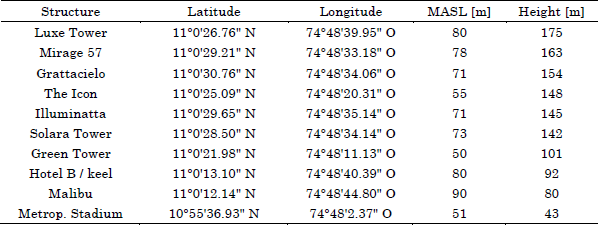
Source: created by the authors.
Indeed, Barranquilla registered the highest incidence of lightning in the studied structures since it has high periods of rain due to movements in the different layers of the atmosphere. Additionally, this city is conditioned by its location, in an intermediate zone between two climatic extremes: the arid north (La Guajira desert) and the humid region to the south that begins in the middle of Magdalena valley and is influenced by the Caribbean Sea, which favors a cyclonic movement and temperature [28]. This phenomenon causes the ocean to be charged with energy opposite the concentrated electrical charge in the clouds, generating lightning flashes that randomly affect the entire city (see Table 3).
Table 3 Elevated structures and specific sites with the highest incidence of lightning in Barranquilla city. The bold sites correspond to tall structures. The amounts in parentheses correspond to the number of floors

Source: created by the authors.
With geographical coordinates of 10.96° -74.87°, Villa Celia has the highest incidence of lightning strokes, with 384 impacts. Likewise, transmission structures and communication towers are structures with an increased incidence of lightning. In Barranquilla, two urban structures are highlighted: the Pumarejo Bridge and the Barranquilla Plaza Hotel, since they presented a high number of impacts of 176 and 107, respectively. The area known as Platanal El Peludo is a place with many buildings, such as Transmission Structures (items 3 and 4) and Telecommunication Tower (item 5), registering that they receive many impacts of 291, 264, and 213, respectively.
Compared with the structures under study (see the ones in bold) that have a higher height, it is evident that in this case, the amount of lightning strokes does not increase with the height of the structures.
Figure 2 shows the geographical location of the elevated structures and hotspots of the city of Barranquilla. The number in the box means the position in the elevated structure table. The elevated structures and specific sites found are located by colors, study structures (purple color), forested areas (green color), buildings (blue color), urbanizations (orange color), transmission structures (red color), refineries (color coffee), and telecommunication towers (pink), respectively. Of the 16 hotspots in Barranquilla, ten correspond to elevated structures (either an elevated study structure, a transmission tower, or a telecommunications antenna), 3 to urbanizations, 2 to commercial areas, and one to wooded areas.
3.2 Medellín
Medellín is a city located in the northeast of the country. It has 158 thunderdays per year and a Ground Flash Density of 11.3 flashes per square kilometer per year [17].
Medellín is the city with the highest incidence of lightning strokes in Colombia, considering its geography facilitates this type of phenomenon. It is located in the geographical center of the Aburrá Valley. Additionally, the mountain ranges that enclose the city give rise to the formation of various microclimates. Indeed, being in the middle of mountains cause daytime warming that favors the development of large cumulus vertical clouds [12]. This phenomenon generates more significant internal movement within the clouds, which have negative and positive charges, generating instability and producing two interrelated elements: lightning flashes and thunder. Based on the above, Table 4 shows the tallest structures in Medellin, located toward the city center. Table 5 shows the places where the highest incidence of lightning is evident in Medellín.
Table 4 Elevated structures analyzed in Medellín city with their respective latitude, longitude, meters above sea level (MASL), and height in meters

Source: created by the authors.
Table 5 Elevated structures and specific sites with the highest incidence of lightning in Medellín city. The bold sites correspond to tall structures. The amounts in parentheses correspond to the number of floors
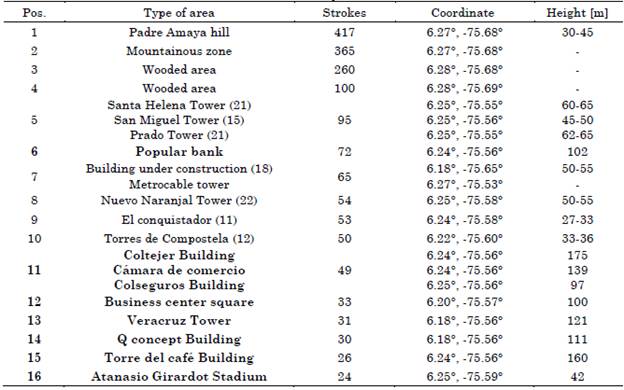
Source: created by the authors.
The areas with the greatest number of strokes are not located in the city’s urban area. The mountainous areas have the most significant affectation because the city is the center of the Aburrá Valley, surrounded by mountainous areas where these phenomena occur [13]. This area is known as Padre Amaya hill with geographic coordinates 6.27°; -75.68° and 417 impacts, where television, radio, military, and civil communications antennas are observed (see Figure 3).

Source: created by the authors.
Figure 3 Geographic location of elevated structures and specific sites with the highest incidence of lightning in Medellín city
Additionally, other structures found during the investigation, such as Towers Santa Helena and San Miguel, and Prado, have lower heights than the structure’s study (see the ones in bold), but they registered many strokes: 95. In contrast, the Popular bank, with a height of 102 m, was struck by 72 impacts. A tower of the Metro Cable system with coordinates 6.277289 °, -75.531284 ° was found within the structures.
Due to its geographical location, the mountainous area presented 65 lightning strokes, being the seventh zone with the highest lightning activity.
Of the 16 hotspots in Medellín, twelve correspond to elevated structures (either an elevated study structure, a transmission tower, or a telecommunications antenna) and four to wooded areas.
3.3. Pereira
Pereira is a city in Colombia’s coffee mountainous region of western Colombia with a keraunic level of 84.5 thunderdays per year and a Ground Flash Density of 4 flashes/km2/year [17]. For the analysis of this city, ten elevated structures were taken into account: The Matecaña International Airport, the Hernán Ramírez Villegas Stadium, and buildings considered elevated structures in the city (see Table 6).
Table 6 Elevated structures analyzed in Pereira city with their respective latitude, longitude, meters above sea level (MASL), and height in meters
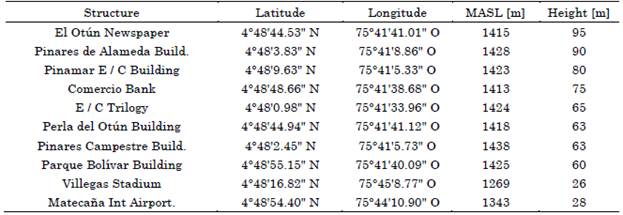
Source: created by the authors.
Table 7 presents the study of the zones with the greatest amount of lightning impacts, like urbanizations, banks, telecommunication towers, transmission structures, the Hernán Ramírez Villegas Stadium, the Matecaña International Airport, and forested areas. As we can see, the area with the highest amount of lightning strokes is a wooded area called Pueblo Nuevo, with 100 impacts. This is far from the city with geographic coordinates of 4.84°, - 75.72°. The same behavior is seen for the first three positions of Table 7, which allows us to conclude that in this city, the sites with the greatest amount of lightning impacts do not correspond to the one’s where elevated structures are located. Additionally, it was possible to identify a transmission tower with 43 impacts.
Table 7 Elevated structures and specific sites with the highest incidence of lightning in Pereira city. The bold sites correspond to tall structures. The amounts in parentheses correspond to the number of floors

Source: created by the authors.
Figure 4 shows the geographical location of the elevated structures and hotspots in the city of Pereira.
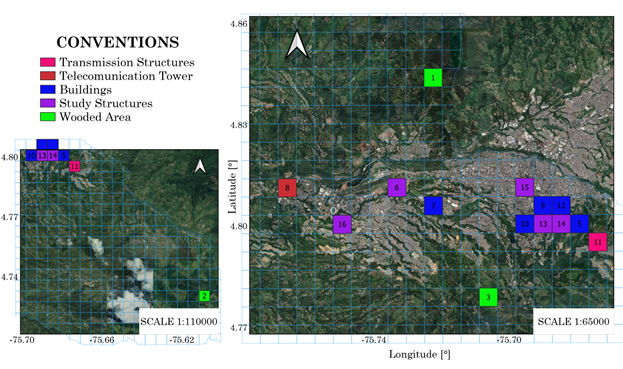
Source: created by the authors.
Figure 4 Geographic location of elevated structures and specific sites with the highest incidence of lightning in Pereira city
Of the 16 hotspots in Pereira, thirteen correspond to elevated structures (either an elevated study structure, a transmission tower, or a telecommunications antenna) and three to wooded areas.
3.4 Barrancabermeja
Barrancabermeja is a city located on the shore of the Magdalena River in the west of the department of Santander. It has a keraunic level of 84.4 thunderdays per year and a Ground Flash Density of 10 flashes/km2/year Barrancabermeja [17]. Table 8 shows the elevated structures in Barrancabermeja.
Table 8 Elevated structures analyzed in Barrancabermeja city with their respective latitude, longitude, meters above sea level (MASL), and height in meters

Source: created by the authors.
The data analysis of elevated structures determined that the place with the greatest amount of lightning impacts is a wooded area with 99 strokes. This area is called Chinchorrera, located in the limits of Yondó and on the banks of the Magdalena River. In this area, a high density of the forested regions is concentrated. It was called this way since it is impossible to determine the existence of structures on this site. The abundance of vegetation is visible since the exploration through Google Street View does not allow us to see the terrain in more detail.
Table 9 shows the areas with the highest lightning activity in the municipality organized from highest to lowest, highlighting the areas with the elevated structures again in bold. From the obtained results, the San Francisco Tower was the structure with the highest amount of lightning impacts of the structures under analysis, with 62 strokes. However, it does not correspond to the tallest structure of those analyzed, such as the 48-meter-high SuperStar Hotel, which presents 46 impacts.
Table 9 Elevated structures and specific sites with the highest incidence of lightning in Barrancabermeja city. The bold sites correspond to tall structures. The amounts in parentheses correspond to the number of floors
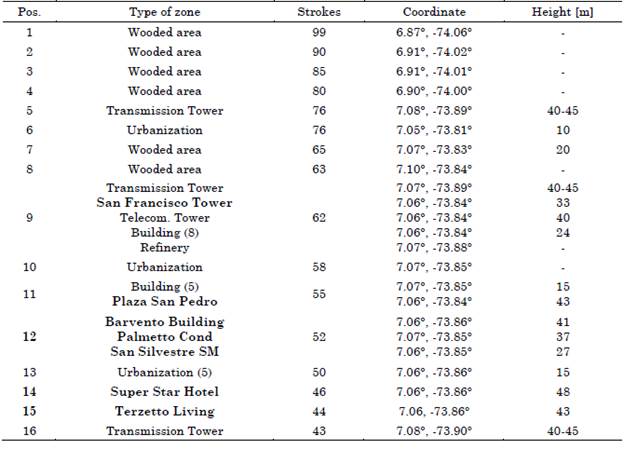
Source: created by the authors.
Figure 5 shows the geographical location of the elevated structures and hotspots of Barrancabermeja.

Source: created by the authors.
Figure 5 Geographic location of elevated structures and specific sites with the highest incidence of lightning in Barrancabermeja city
Of the 16 hotspots in Barrancabermeja, eight correspond to elevated structures (either an elevated study structure, a transmission tower, or a telecommunications antenna), 2 to urbanizations, and six to wooded areas.
Figure 6 shows the classification of the 16 hotspots found in the four study cities. Most of hotspots in these places are located in high structures such as buildings, transmission lines, and telecommunications antennas.
4. DISCUSSION
The Intertropical Confluence Zone mainly influences lightning activity in Colombia since the trade winds from the southeast and northeast converge in the country [17]. So, there is a bimodal behavior in the amount of CG lightning flashes, with peaks in the months of April- May and September-October [4], [16], [17]. This monthly variation is maintained in Medellín and Barranquilla, as observed in [20] and Barrancabermeja [29].
By analyzing the precipitation levels in [30], the four study cities present the same bimodal behavior with peaks in the months mentioned above, with more marked maximums in Medellín and Pereira, up to 200 and 250 mm of rain reached, respectively. It follows that the level of precipitation is related to the amount of lightning in these sites.
Regarding meteorological variables and their relationship with lightning activity, in cities such as Medellin, when the atmospheric pressure decreases between 2:00 pm and 6:00 p.m., there is a considerable increase in CG lightning flashes. The same happens in Barranquilla, where in March, April, May, and September, October, November, there are peaks of maximum lightning activity around 3:00 p.m. where there is a noticeable decrease in atmospheric pressure [20]. Regarding temperature, lightning activity increases hours after the highest temperatures are recorded. According to [31], the increase in temperature causes the air to heat up and expand. It manages to ascend more quickly due to the influence of the topography and helps in the generation of storms. Thus, the hotter and more humid the environment, the more lightning activity. This behavior is shown in [32] [33], where it is stated that variations between 1-2° cause an increase in lightning activity between 30-50 %.
Regarding humidity, it was found that the days of high lightning activity in Medellín and Barranquilla present greater amounts of water vapor in the atmosphere, which favors the formation of storm clouds [20]. According to the results, the highest incidence of lightning in study structures was found in Barranquilla, where its average annual relative humidity values are between 80-85 %, as shown [30]. These values exceed those measured in the three other cities in this study, between 75-80 %.
The above may explain the high number of lightning strikes in Barranquilla compared to Medellín, Pereira, and Barrancabermeja. Lightning activity in cities of the Andean region such as Barrancabermeja, Medellín, and Pereira is also affected by southern winds, the Intertropical Confluence Zone, and local winds of the valley-mountain-valley type [20]. In these areas, the trade winds transport humidity. For this reason, as indicated above, there is a tendency to increase atmospheric activity and, consequently, lightning strokes since it generates instability in the atmosphere.
Particularly in Medellín, the influence of the Chorro del Chocó is seen (a surface air current coming from the Pacific Ocean), which interacts with the East Trade winds and can also favor the formation of thunderstorms [34]. The winds in Barranquilla come specifically from the North and Northeast, as observed in [30].
Topography is another factor that affects lightning activity. Cities such as Barrancabermeja preserved the bimodal behavior stated at the beginning [29]. This city is located on the western side of the Yariguíes Mountain range. These mountain ranges, which reach heights of up to 3475 meters above sea level, act as a natural barrier to the humid and warm winds that circulate, forcing them to rise. The above favors the charge transfer by the collision between ice and hail particles present in the atmosphere and, therefore, the formation of electrical storms in the municipalities located in the foothills and valleys [29]. The same behavior occurs in Pereira, situated between the western and eastern mountain ranges. This city is surrounded to the east by large mountain ranges formed by the Santa Isabel and Quindío snowy, which exceed 4800 meters above sea level, and to the west by the Tatama and Paramillo hills, that exceeds 3000 meters above sea level. For its part, Medellín is located on the side of the western mountain range where is found the Nudo de Paramillo knot, a mountain range that can also affect the lightning activity of the city in question.
It has also been shown that thunderstorms' topology and the heights of the electrical charge regions are highly related to the CG lightning flash rates. The three-pole structure in which a lower positive region, a negative central region, and an upper positive region show the highest CG flash rate. Likewise, the upper positive charge region's presence and height increase this flash rate. At the same time, the presence of the lower positive region favors high lightning currents [35]. Research such as [23] and [36] carried out on the Caribbean coast and in the Magdalena medio colombiano show that storms have this tripolar structure and that the heights of the load centers are generally higher than those found in temperate zones, which can explain the high lightning rates in tropical regions like Colombia.
Finally, the urban effect is another variable that influences the number of lightning strokes in a region since it includes the modification of climate and weather due to human actions. This effect is influenced by the Urban Heat Islands (UHI), which correspond to an increase in temperature in urban environments concerning their surroundings [37]. It is also affected by atmospheric aerosols or pollution, which affect the climate in terms of surface temperature, solar radiation, and precipitation [20].
5. CONCLUSIONS
Of the areas studied, Medellín has the place with the highest activity of cloud to ground lightning flashes in the periods 2016, 2017, 2018, with 417 impacts. This site is called Cerro Padre Amaya, with geographic coordinates of 6.27°, -75.68°. Considering that it is a city with geography that facilitates this type of phenomenon, it is located in the geographical center of the Aburrá Valley and is surrounded by high mountains. This city presents a particular behavior since its first four hotspots are located in the same area.
The elevated structures with the highest amount of lightning impacts belong to Barranquilla, specifically the Barranquilla Plaza Hotel with 107 strokes. In this city, the transmission and telecom structures have the highest impacts compared to the other cities’ understudy. They are attributing this result to the fact that the city is a semi-arid area where the northeast trade winds blow parallel to the coast, absorbing moisture, pushing it towards the interior of the Caribbean Region to the foothills of the Andes Mountain range, where they produce abundant rainfall.
With the lightning information sources provided by the LINET network, it was possible to verify that although the first hotspots in the study cities are far from the urban area, as observed in Medellín, Pereira, and Barrancabermeja, there is a marked influence of urban planning in determining the sites of high lightning activity, which allows us to infer that urban planning and the presence of elevated structures increase lightning activity. Likewise, it was verified that most hotspots correspond to elevated structures.
A possible relationship between some meteorological variables and lightning activity in the analyzed cities was determined. In this way, the time slots where CG lightning flashes increases correspond to the periods in which there were drops in atmospheric pressure. Likewise, lightning activity increases hours after the highest temperatures are recorded and at times when higher percentages of humidity are recorded in the atmosphere. Since Colombia is located in the Intertropical Confluence Zone, the hot and humid winds that upwards are driven by the mountain ranges also affect the formation of thunderstorms and, therefore, the lightning flash rates of the study cities.
Lightning activity in the four cities presented in this work can also be influenced by the relief since the mountains serve as a natural barrier to the winds forcing them to rise. The above increases the interaction between hydrometeors suspended in the atmosphere. It also favors the charge transfer by collisional and, therefore, the initiation of lightning leaders. Likewise, a possible relationship between the level of precipitation and the amount of lightning is established since the annual peaks of these two variables coincide. It is proposed that charge distributions in thunderclouds and the heights of their charge centers are also determinants of CG lightning flash rates.
Future work proposes investigating the repercussions of the urban effect on CG lightning flash rates in various Colombian cities over a considerable period. It means the influence of heat islands formed in urban environments and atmospheric aerosols.
Likewise, find the affectation that land use has on lightning activity. The characterization of the hotspots found in this work is also proposed through lightning parameters such as multiplicity, polarity, and return discharge current, making monthly and hourly distributions, probability distributions, and other statistical analyzes applicable to the protection of elevated structures against CG lightning flashes.

















